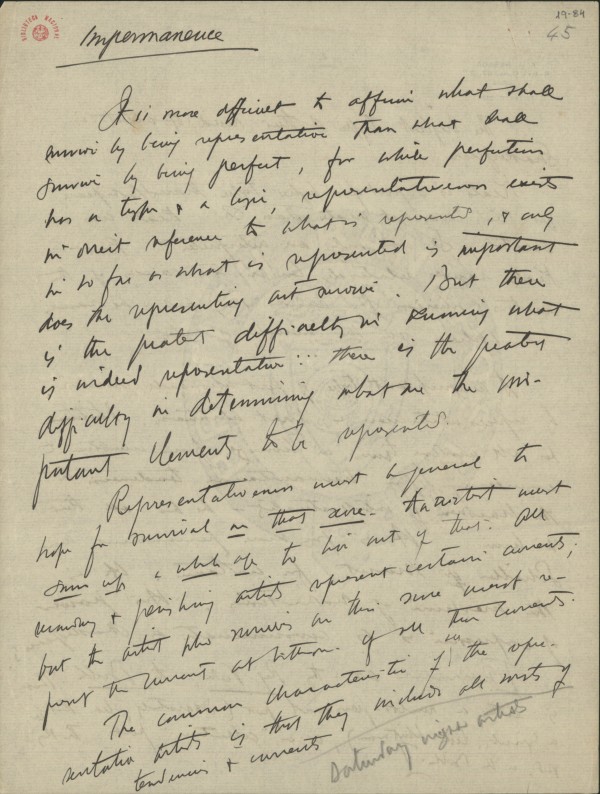Identificação
[19 – 84]
Impermanence
It is more difficult to affirm what shall survive by being representative than what shall survive by being perfect, for while perfection has a type and a logic, representativeness exists in direct reference to what is represented, and only in so far as what is represented is important does the representing art survive. But there is the greatest difficulty in knowing what is indeed representative because there is the greatest difficulty in determining what are the important elements to be represented.
Representativeness must be general to hope for survival on that score. An artist must sum up a whole age to live out of that. All secondary and perishing artists represent certain currents; but the artist who survives on this score must represent the current at the bottom of all those currents.
The common characteristic of all the representative artists is that they include al1 sorts of tendencies and currents.
_______
Saturday night artists
[84v]
The highest type of this kind of artist is Shakespeare.
Keats is a poet of a higher type than Shakespeare, yet Keats was not greater than Shakespeare. Keats was a creator; Shakespeare was only an interpreter. But Keats ranks relatively low in the ranks of the creators; whereas Shakespeare ranks very high – he ranks first, I believe – in the number of interpreters.
A magnificent type of poet who will survive by representativeness is Walt Whitman. Whitman has all modern times in him, from occultism to engineering, from humanitarian tenderness to the hardness of intellectuality – he has all this in him. He is far more permanent than |Schiller or| Musset, for instance. He is the medium of Modern Times. His power of expression is as consummate as Shakespeare’s. His manner of survival is that of the Rig-Veda and the Bible, representative by plurality of inspiration.
[Representative art: The Rig-Veda, the Bible. That is: either a multi-personal poet (dramatical, like Shakespeare, or lyrical, like Walt Whitman), or a “collective” poet: the Rig-Veda, or the Bible).]
[19 – 84]
Impermanência
É mais difícil afirmar o que deverá sobreviver por ser representativo do que o que deverá sobreviver por ser perfeito, pois enquanto a perfeição tem um tipo e uma lógica, a representatividade existe por referência directa com aquilo que é representado e apenas na medida em que o que é representado é importante é que a arte representativa sobrevive. Mas existe uma enorme dificuldade em conhecer o que é, de facto, representativo, porque existe uma enorme dificuldade em determinar quais são os elementos importantes a serem representados.
A representatividade deve ser geral para aspirar à sobrevivência nessa base. Um artista deve resumir toda uma época para lhe sobreviver. Todos os artistas secundários e que perecem representam certas correntes; mas o artista que sobrevive nesta base deve representar a corrente que está na base de todas essas correntes.
A característica comum a todos os artistas representativos é que eles incluem todas as espécies de tendências e correntes.
_______
Artistas de Sábado à noite
[84v]
O tipo mais elevado deste género de artista é Shakespeare.
Keats é um poeta de um tipo superior a Shakespeare, contudo Keats não era maior do que Shakespeare. Keats era um criador; Shakespeare era apenas um intérprete. Mas Keats está relativamente baixo na classificação dos criadores; enquanto Shakespeare está muito alto – ele figura em primeiro plano, creio – no número dos intérpretes.
Um tipo magnífico de poeta que sobreviverá pela representatividade é Walt Whitman. Whitman tem todos os tempos modernos nele, desde o ocultismo à engenharia, da ternura humanitária à dureza da intelectualidade – ele possui tudo isso nele. É bem mais permanente do que |Schiller ou| Musset, por exemplo. É o médium dos Tempos Modernos. O seu poder de expressão é tão consumado como o de Shakespeare. O seu modo de sobrevivência é o do Rig-Veda e da Bíblia, representativo pela pluralidade de inspiração.
[Arte representativa: o Rig-Veda, a Bíblia. Isto é: ou um poeta multi-pessoal (dramático, como Shakespeare, ou lírico, como Walt Whitman), ou um poeta “colectivo”: o Rig-Veda ou a Bíblia).]
Classificação
Dados Físicos
Dados de produção
Dados de conservação
Palavras chave
Documentação Associada
Publicação integral: Fernando Pessoa, Heróstrato e a Busca da Imortalidade, edição de Richard Zenith, Lisboa, Assírio & Alvim, 2000, pp. 236-237; 245-246.



